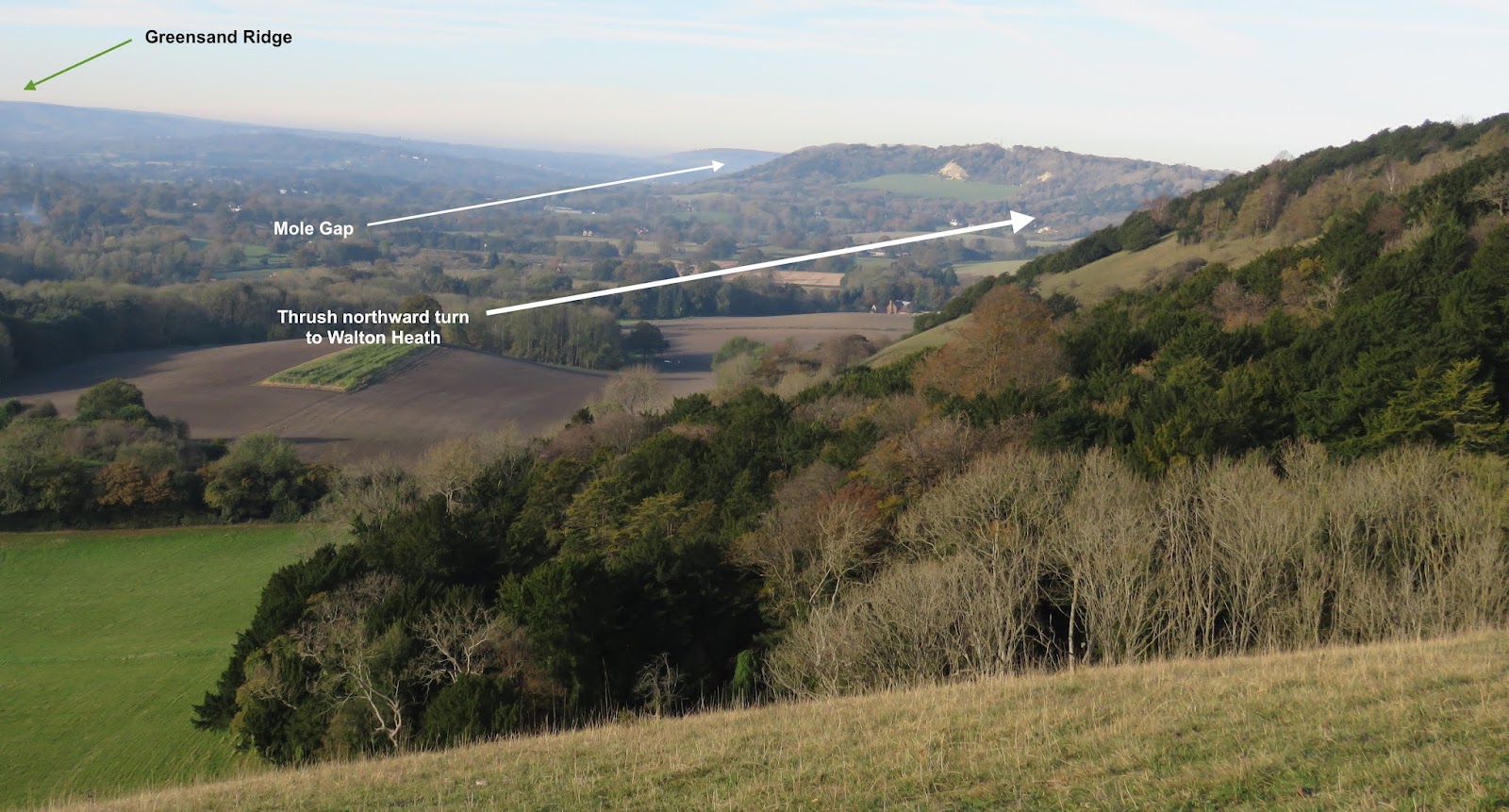The 'always learning' curve
We are almost at the end of the autumn visible-migration season, and, so far, it has been pretty decent. Following on from a massive Redwing day, and a more than passable Fieldfare-fest, I have spent the past two mornings at Colley Hill, on the North Downs just above the town of Reigate. Here are the two watches in detail, taken from my postings on Trektellen:
Friday's session was four-and-a-half hours of birding that had its rewards, although the bird stream didn't really get going. Of the thrushes, it was three flocks of Blackbird (50, 27 and 25) that were the most interesting, as I cannot recall watching this species visibly migrate through the county before, certainly not beyond the odd one or two. The four Hawfinches were in a flock and briefly alighted. Watching many of the birds as they moved westward was instructive. Most arrived from the east, flying parallel with the scarp slope, maybe 100-200m out (to the south). Plenty just carried on through towards the Mole Gap, but a significant number veered off to the north, flying up the slope where the downs indent (by Juniper Hill) which leads onto the high ground at Walton Heath. The shorter distance to take, if they are heading towards the Mole Gap, is to head out across the farmland. So maybe they are continuing northwards? When I have vis-migged at the Mole Gap, good numbers of birds do appear from the east, hugging the scarp slope, so it might not be as simple as birds slipping north at the Juniper Hill indent. Wind and weather may play a role in such choices. Do the birds pick up the downs again further along, before reaching the Mole Gap? Do some of them carry on NW and miss the gap altogether?
Today's watch was very interesting indeed. I started at the Colley Hill viewpoint, and although a few birds were moving, after an hour I was pretty sure that it was going to be an 'ordinary' morning. I checked the various migration-themed What'sApp group messages, and was surprised to see that both Wes Attridge (Capel) and Graham Stephenson (Tweseldown) were reporting over 1,000 Redwings through in the first hour of daylight - my total had barely reached 400. I have two viewpoints at Colley Hill for the purposes of recording visible migration - the scarp slope (looking south, where I now stood) - and Mogador (looking north, just 800m away). I have had some success at the later vantage point before, and have suspected that it might be better than the scarp slope, so cut my losses and took up position by 08.00hrs. My first scan of the sky told me know all that I needed to know, as several hundred thrushes were up in the air, heading westwards. I stood rooted to the spot for the following three and a bit hours, witnessing a tremendous surge of Redwings between 08.45 - 09.45hrs. Had these birds been passing in number north of the scarp slope as I stood there during the first hour of daylight? I will never know, but in the light of Wes and Graham's data, I strongly suspect that they had been. Maybe I need to give this Mogador vantage point more time next autumn?
I suppose it is true of everywhere, but what is needed to answer these questions, is a team of birders who are happy to stand still in one place, over a few weeks each autumn, and record what flies overhead - and in which direction they are travelling. The scarp slope between Colley and Box Hills is riddled by wooded folds and valleys, and topped by wide-open spaces and big skies (as the photograph of Mogador, below, shows). And how wide is a thrush stream on any given day? On 13th October, in Banstead, I recorded a staggering 26,013 (click here to see more detail). That was the same day that Leith Hill had 34,747. Those two sites are 18 miles apart. Were there similar numbers overflying other sites between, or were the thrushes following discrete streams - or several delineated corridors of travel - within this 18 mile band? Were there others moving outside of it? Tweseldown (just over the Surrey county boundary in Hampshire and almost due west of Colley/Mogador) is a very well-watched site, with almost daily visible-migration coverage at the peak times. Where do their Redwings come from? Off of the North Downs? From somewhere else? And if somewhere else, are they being picked up before they get to them? Sad thing is, we'll most probably never know.






Comments
Thats exciting stuff.It amazing what can be seen. I seem to recall that David Lack studied migration on the North Downs way back in the 1960's perhaps. There was a huge interest in visible migration then.I remember DIM Wallace was the organiser for visible migration in The London area around the same time.The radar studies showed that a lot of migration was out of visible range and so the incentive wavered.
Maybe it needs a co-ordinator/inspirer now.
Best Wishes
Bob